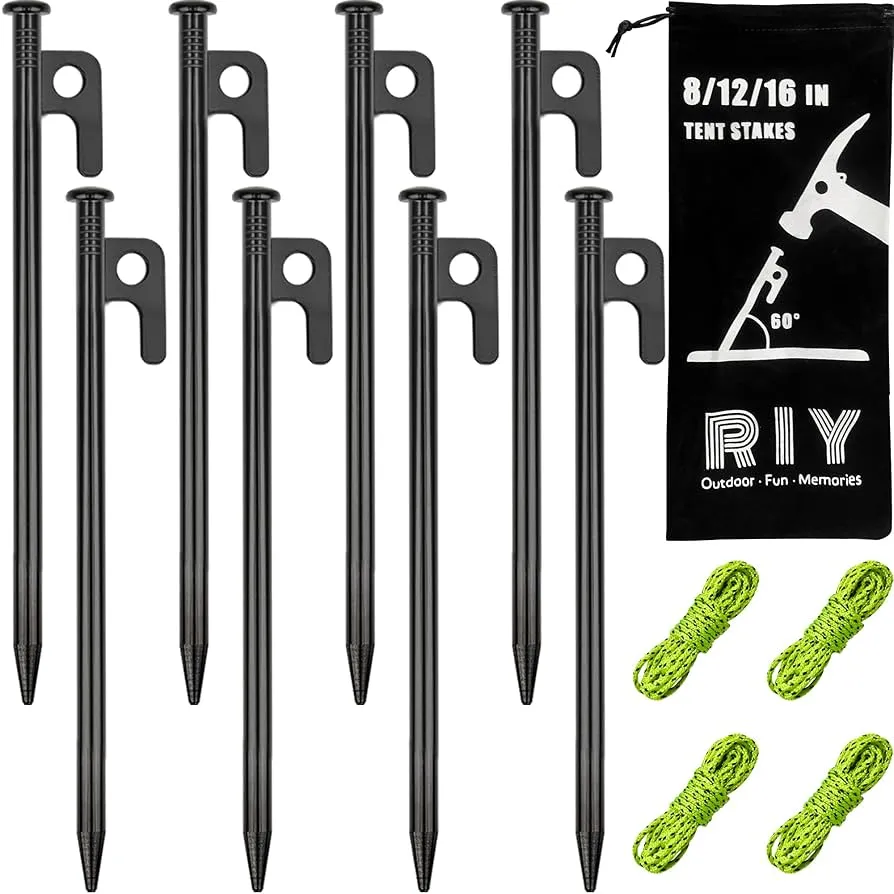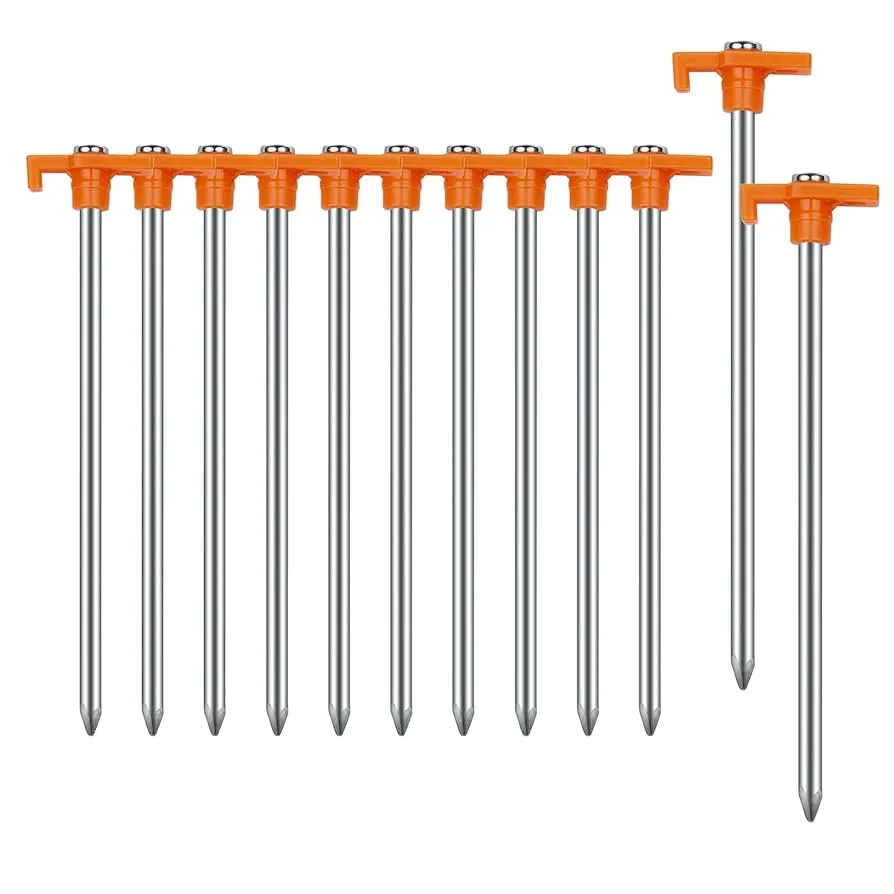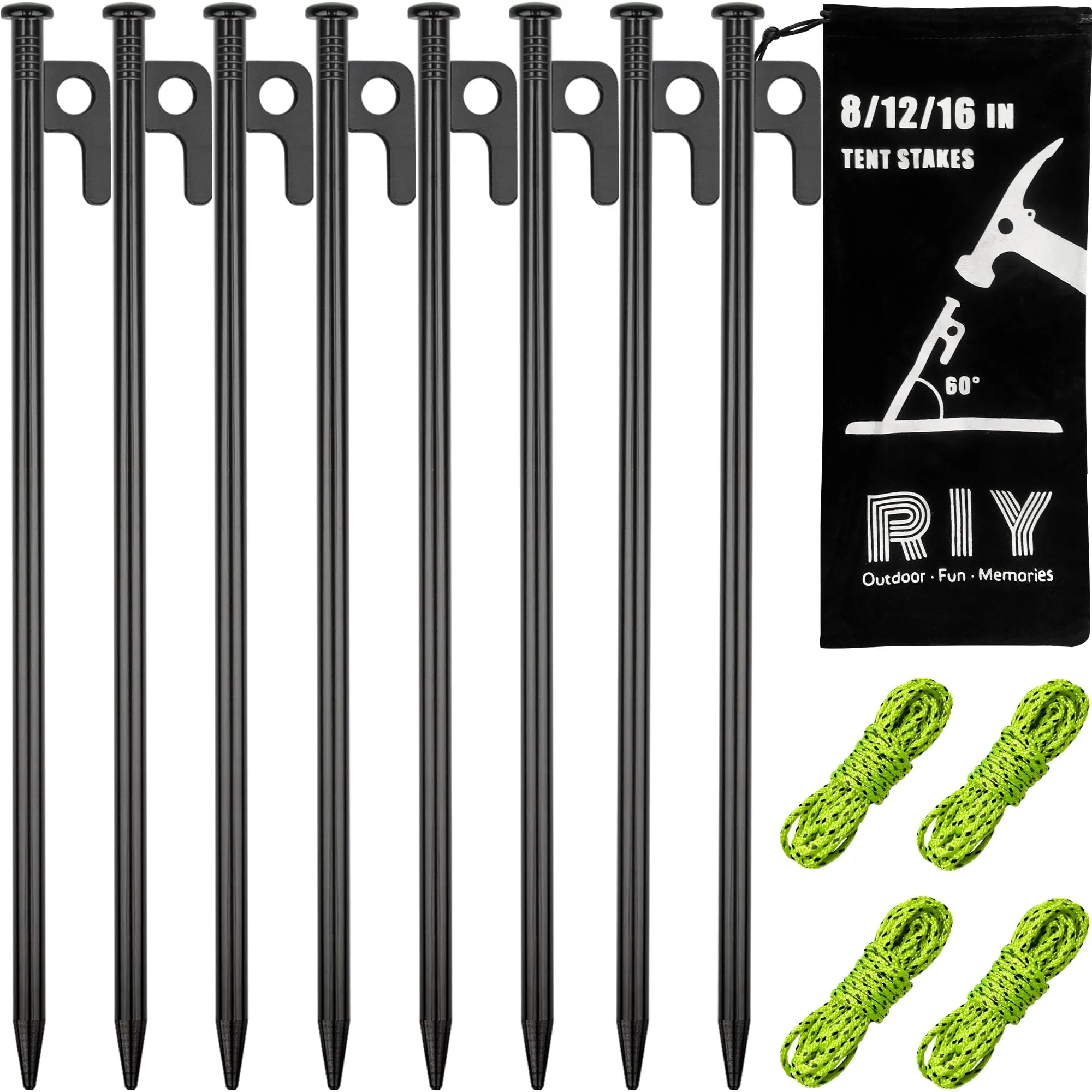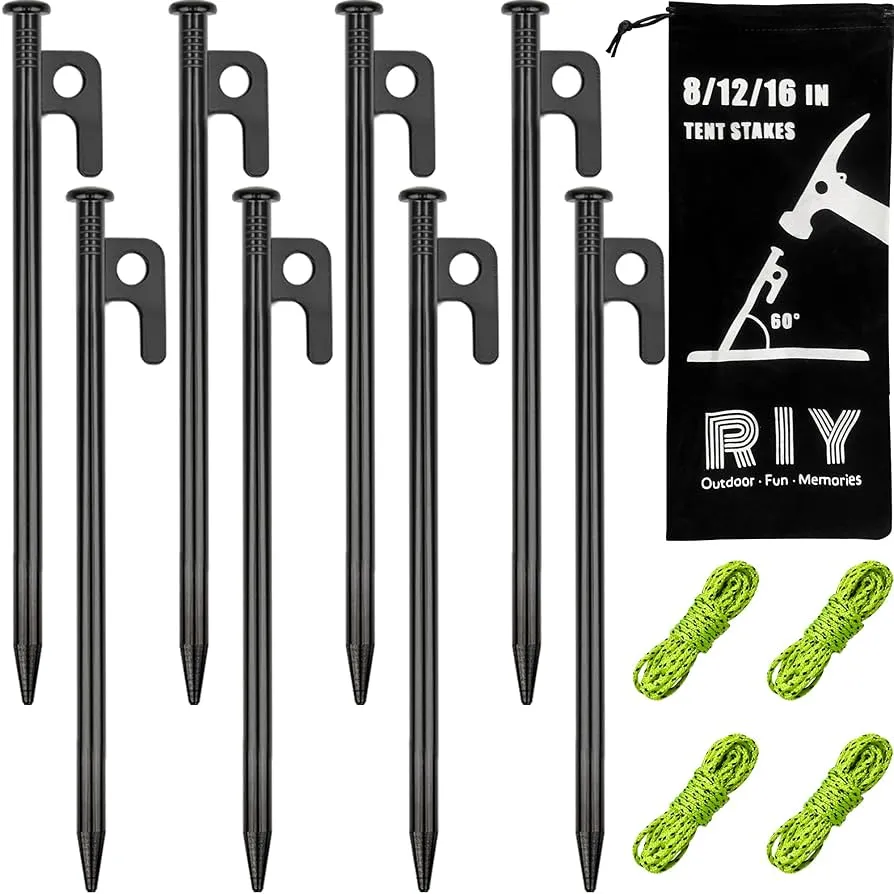After years of camping in challenging conditions from the Rocky Mountains to Texas state parks, I've learned that heavy duty tent stakes are the difference between a secure night's sleep and a tent flying away in the wind. This comprehensive guide shares my field-tested knowledge to help you choose the perfect stakes for your outdoor adventures. Visit Nature Guests for more expert camping advice.
What Makes Heavy Duty Tent Stakes Essential for Serious Campers

During my camping adventures across various terrains, I've witnessed countless tents succumb to inadequate anchoring. The flimsy aluminum stakes that come with most tents simply aren't designed for challenging conditions. Heavy duty tent stakes represent a crucial upgrade that transforms your camping experience from anxiety-inducing to genuinely relaxing.
Professional-grade heavy duty tent stakes are engineered from high-carbon steel or aircraft-grade aluminum, offering superior holding power in diverse ground conditions. Unlike standard stakes that bend or break under pressure, these robust anchors maintain their integrity even when subjected to extreme weather conditions. I remember camping in Colorado during unexpected 40-mph winds – while other campers struggled with collapsed tents, my setup remained rock-solid thanks to premium steel tent stakes.
The engineering behind heavy duty tent stakes focuses on three critical factors: material strength, design geometry, and holding power. Quality stakes feature heat-treated steel construction that resists bending, pointed tips for easier penetration, and strategic head designs that maximize ground contact. This combination ensures reliable performance whether you're camping on rocky mountain terrain or sandy beach environments.
Investment in quality heavy duty tent stakes pays dividends in safety, peace of mind, and equipment longevity. Rather than replacing bent stakes after every trip, professional-grade anchors last for years of regular use. Most importantly, they provide the security needed for comfortable sleep, knowing your shelter will remain intact regardless of overnight weather changes. For comprehensive guidance on various stake types, explore our detailed best tent stakes comparison.
Top 5 Heavy Duty Tent Stakes: Expert Reviews and Recommendations

1. MSR Groundhog Tent Stakes - The Gold Standard
After extensive field testing, MSR Groundhog stakes consistently outperform competitors in both holding power and durability. These heavy duty tent stakes feature a unique Y-beam design that maximizes strength while minimizing weight. The aluminum construction resists corrosion, making them ideal for coastal camping.
Professional backpackers worldwide trust MSR Groundhogs for their reliability in challenging conditions. The reflective cord attached to each stake prevents loss during nighttime setup, while the sharp point penetrates even compacted soil with minimal effort.
2. Heavy Duty Steel Tent Stakes 8-Pack - Best Value
For car campers seeking maximum holding power without premium pricing, these 8-inch steel stakes deliver exceptional performance. The robust construction handles rocky terrain and extreme weather conditions that would destroy lighter alternatives. I've used these extensively in Texas state parks where the ground can be unforgivingly hard.
The steel construction provides superior strength compared to aluminum alternatives, though the trade-off is increased weight. For heavy duty tent stakes applications where maximum security is paramount, the extra weight is justified by their exceptional holding power and longevity.
3. Coleman Steel Tent Stakes - Reliable Traditional Choice
Coleman's reputation for dependable camping gear extends to their steel tent stakes, which provide excellent value for traditional camping applications. These 10-inch stakes offer substantial holding power for family tents and car camping scenarios where weight isn't a primary concern.
The straightforward design prioritizes function over fancy features, making these heavy duty tent stakes an ideal choice for occasional campers who need reliable performance without premium pricing. Their robust construction handles normal camping conditions with ease.
Each of these stakes excels in different scenarios, but all provide the security and durability that define quality heavy duty tent stakes. For specialized applications, consider exploring our guides on heavy-duty metal tent stakes and Groundhog tent stakes for detailed comparisons.
Complete Buying Guide for Heavy Duty Tent Stakes
Selecting the right heavy duty tent stakes requires understanding your specific camping needs and environmental conditions. After years of testing various stakes across different terrains, I've developed a systematic approach to choosing the optimal anchoring solution for any camping scenario.
Key Factors to Consider
Ground Conditions
Hard-packed soil, rocky terrain, and sandy conditions each require different stake designs. Steel stakes excel in rocky areas, while specialized sand stakes work better for beach camping.
Weight Considerations
Backpackers prioritize lightweight aluminum stakes, while car campers can choose heavier steel options for maximum holding power.
Material choice significantly impacts performance and durability. High-carbon steel offers maximum strength but adds weight, while aircraft-grade aluminum provides excellent strength-to-weight ratios. For most camping applications, I recommend starting with versatile aluminum stakes and upgrading to steel for extreme conditions or permanent installations.
Length selection depends on your tent size and expected weather conditions. Standard 7-8 inch stakes work for most applications, while 10-12 inch stakes provide additional holding power for large tents or windy conditions. I always carry a mix of lengths to adapt to varying ground conditions and wind exposure.
Budget considerations should balance upfront cost with long-term value. While premium heavy duty tent stakes cost more initially, their durability and performance often make them more economical over time compared to repeatedly replacing cheaper alternatives that bend or break.
Professional Installation Tips and Best Practices

Proper installation technique maximizes the holding power of your heavy duty tent stakes while preventing damage to both stakes and tent. During my years of camping instruction, I've observed that most tent failures result from improper staking rather than inadequate equipment.
The optimal stake angle is 45 degrees away from the tent, creating a guy line that bisects the angle between the stake and the tent attachment point. This configuration maximizes holding power while reducing stress on both the stake and tent fabric. I learned this technique from seasoned park rangers who anchor emergency shelters in extreme conditions.
Critical Installation Steps
Begin by clearing the stake path of rocks and debris that could deflect or damage the stake. Drive stakes with firm, controlled strikes rather than excessive force that might bend the stake or damage the head. For heavy duty tent stakes in hard ground, consider using a dedicated stake hammer rather than a standard camping hatchet.
Ensure stakes penetrate at least 6 inches into the ground for adequate holding power. In sandy or loose soil, drive stakes deeper or use specialized sand stakes with larger surface areas. Always test stake security before fully tensioning guy lines.
Environmental factors significantly influence installation approach. In rocky terrain, probe gently to locate soil pockets rather than forcing stakes against immovable rocks. For frozen ground, allow stakes to warm in the sun before installation, as cold metal becomes more brittle and prone to breaking.
Removal technique is equally important for stake longevity. Use a stake puller or pliers to extract stakes vertically rather than levering them out, which can bend even high-quality heavy duty tent stakes. Clean stakes thoroughly before storage to prevent corrosion and ensure they're ready for your next adventure.
Heavy Duty Tent Stakes vs Regular Stakes: Performance Analysis
The performance gap between heavy duty tent stakes and standard tent stakes becomes apparent in challenging conditions. Regular aluminum stakes that come with most tents are designed for fair weather and soft ground conditions. When faced with rocky terrain, hard-packed soil, or strong winds, these lightweight stakes often fail catastrophically.
Regular Stakes Limitations
- Bend easily in hard ground
- Limited holding power in wind
- Break when over-driven
- Poor performance in rocky soil
- Require frequent replacement
Heavy Duty Advantages
- Resist bending and breaking
- Superior holding power
- Penetrate difficult ground
- Handle extreme weather
- Last for years of use
Field testing reveals that heavy duty tent stakes provide 3-5 times the holding power of standard stakes in identical conditions. This translates to significantly improved tent stability, reduced guy line tension requirements, and enhanced safety margins during severe weather events. The investment in quality stakes often prevents costly tent damage from inadequate anchoring.
Weight differences between stake types vary significantly. Standard aluminum stakes typically weigh 0.5-1 ounce each, while heavy duty aluminum stakes range from 1-2 ounces. Steel stakes can weigh 2-4 ounces each but provide maximum holding power. For backpacking, the weight penalty is offset by carrying fewer stakes due to their superior performance.
Cost analysis favors heavy duty stakes over the long term. While regular stakes cost $1-3 each and require frequent replacement, quality heavy duty stakes range from $3-8 each but last for years. The peace of mind and improved camping experience justify the initial investment, especially for frequent campers who rely on their gear in challenging conditions.
Maintenance and Care for Long-lasting Performance
Proper maintenance extends the lifespan of your heavy duty tent stakes while ensuring they perform reliably when you need them most. My oldest stakes have been in service for over a decade thanks to consistent care and proper storage practices that prevent corrosion and damage.
Essential Maintenance Routine
After each camping trip, clean stakes thoroughly with water and a stiff brush to remove soil, sand, and organic debris. Salt exposure from coastal camping requires immediate freshwater rinsing to prevent accelerated corrosion. Dry stakes completely before storage to prevent rust formation.
Inspect stakes regularly for signs of wear, including bent tips, head damage, or corrosion spots. Address minor issues immediately rather than waiting for complete failure. A light coating of oil or corrosion inhibitor extends the life of steel stakes in humid storage conditions.
Storage organization prevents damage and makes setup more efficient. I organize stakes by type and length in dedicated containers, with cushioning to prevent impacts that could damage points or heads. Reflective cord or bright tape helps identify stakes quickly during setup and prevents loss in field conditions.
Seasonal maintenance includes thorough inspection and any necessary repairs or replacements. Check that stake bags or containers haven't developed holes that could lead to loss. Replace any stakes showing significant wear before they fail during critical use. Quality heavy duty tent stakes represent a long-term investment that rewards proper care with years of reliable service.
Emergency field repairs can extend stake usability when replacement isn't immediately possible. Straightening bent stakes requires gradual pressure rather than sharp bending that could create stress fractures. For comprehensive information about stake varieties and maintenance, visit our detailed guide on Heavy-Duty Tent stakes.
Conclusion
Investing in quality heavy duty tent stakes transforms your camping experience from anxiety-inducing to genuinely relaxing. After years of testing various stakes across diverse conditions, I'm convinced that proper anchoring equipment is the foundation of safe, comfortable outdoor adventures.
The stakes reviewed in this guide represent the best options currently available, each excelling in specific applications while providing the reliability that defines professional-grade equipment. Whether you choose MSR Groundhogs for backpacking, steel stakes for maximum holding power, or versatile options from Coleman, you're investing in equipment that will serve you faithfully for years to come.
Remember that proper installation and maintenance are as important as choosing quality stakes. With the right equipment and techniques, you'll sleep soundly knowing your shelter will remain secure regardless of overnight weather changes. Your adventures await – make sure they're anchored with confidence.
Ready to Upgrade Your Camping Setup?
Don't let inadequate stakes ruin your next outdoor adventure. Start with professional-grade anchoring equipment that provides the security and peace of mind you deserve.


